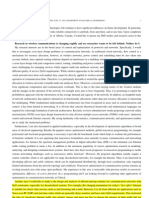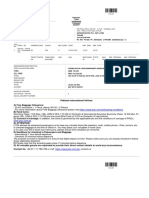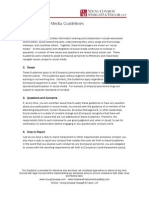API Testing
Uploaded by
thuanbakhacAPI Testing
Uploaded by
thuanbakhac1.
RESTful API:
REST (Representational State Transfer) is an architectural style for distributed systems
such as the internet.
It is based on a client-server model where each service is viewed as a resource that can
be accessed via standard HTTP methods (GET, POST, PUT, DELETE).
REST APIs are lightweight, easy to use, and widely adopted due to their simplicity and
compatibility with various platforms and programming languages.
They typically use JSON (JavaScript Object Notation) for data exchange, which is
lightweight and easy for both humans and machines to read and write.
RESTful APIs are stateless, meaning each request from a client contains all the
information necessary for the server to fulfill it, without requiring the server to store any
session information.
2. SOAP API:
SOAP (Simple Object Access Protocol) is a protocol for exchanging structured
information in the implementation of web services.
It relies on XML (Extensible Markup Language) for message format and HTTP or SMTP
for message negotiation and transmission.
SOAP APIs are more rigid and complex compared to RESTful APIs, often requiring
specialized tooling for development and consumption.
They offer features like security, transactions, and reliability, making them suitable for
enterprise-level applications where these features are crucial.
SOAP APIs support more advanced functionalities such as RPC (Remote Procedure Call)
and messaging standards like WS-Security.
3. GraphQL (Graph Query Language)
Query Language: Clients define the structure of the response, asking for exactly
what they need.
Single Endpoint: All interactions happen through a single endpoint.
Strong Typing: Schema defines types and relationships between types.
Advantages:
Efficiency: Reduces over-fetching and under-fetching by allowing clients to request
exactly what they need.
Flexibility: Clients can evolve independently of servers.
Self-Documenting: The schema and types serve as documentation.
Disadvantages:
Complexity: Requires a more complex setup and understanding.
Caching: More challenging to implement traditional caching mechanisms compared
to REST.
Overhead: Initial performance can be lower due to the need to parse and validate
queries.
Use Cases:
Applications with complex relationships and data requirements, such as social
networks.
Mobile applications where bandwidth efficiency is crucial.
Feature/
Aspect REST API SOAP API GraphQL
XML-based, transport
Protocol HTTP agnostic (HTTP, SMTP) HTTP
Architecture
Style Resource-based Protocol-based Query language
Data Format JSON, XML, HTML, etc. XML JSON
Endpoint Multiple endpoints (one Single endpoint for all
Structure per resource) operations Single endpoint
HTTP methods (GET, POST, Specific operations
Operations PUT, DELETE) defined in WSDL Queries and mutations
Can be stateless or
Stateless Yes stateful Yes
Standardized SOAP fault
Error Handling HTTP status codes messages Custom error handling
Security OAuth, JWT, SSL/TLS WS-Security, SSL/TLS OAuth, JWT, SSL/TLS
Easy to implement HTTP More complex, less Challenging, custom
Caching caching common solutions needed
Documentatio Self-documenting via
n Swagger/OpenAPI, RAML WSDL schema
Simple, easy to Complex, steep learning Moderate, requires
Ease of Use understand curve understanding schema
Higher overhead due to Efficient, but initial
Performance Efficient, less overhead XML and envelopes overhead
CRUD operations, simple Enterprise applications, Complex queries, mobile
Use Cases services complex transactions apps, social networks
Scalability, simplicity, Reliability, formal Efficiency, flexibility,
Advantages flexibility contracts, extensibility reduced data transfer
Over-fetching/under- Complexity, performance
Disadvantages fetching overhead Complexity, caching issues
You might also like
- Second Quarter - Module 35: MathematicsNo ratings yetSecond Quarter - Module 35: Mathematics23 pages
- API & Its Types: 1. History, Background & EvolutionNo ratings yetAPI & Its Types: 1. History, Background & Evolution3 pages
- SOAP_API_REST_API_IN_SALESFORCE__1712552901No ratings yetSOAP_API_REST_API_IN_SALESFORCE__17125529013 pages
- Web Lecture Week 13 Updated 26112024 112019amNo ratings yetWeb Lecture Week 13 Updated 26112024 112019am26 pages
- Techgigwebservices 140514010219 Phpapp01No ratings yetTechgigwebservices 140514010219 Phpapp0137 pages
- REST vs. SOAP_ Choosing the Right API ProtocolNo ratings yetREST vs. SOAP_ Choosing the Right API Protocol8 pages
- Restfulwebservices 130929131145 Phpapp02No ratings yetRestfulwebservices 130929131145 Phpapp0224 pages
- Notes Du 07 03 2024 Architecture RéseauNo ratings yetNotes Du 07 03 2024 Architecture Réseau15 pages
- Evaluate the use of REST APIs Vs GraphQL in web...No ratings yetEvaluate the use of REST APIs Vs GraphQL in web...2 pages
- Introduction to Concepts for Lab Assignments on API, Web ServicesNo ratings yetIntroduction to Concepts for Lab Assignments on API, Web Services3 pages
- Component Architecture - Kanishk MishraNo ratings yetComponent Architecture - Kanishk Mishra18 pages
- Chen 2017 J. Phys. Conf. Ser. 910 012016No ratings yetChen 2017 J. Phys. Conf. Ser. 910 0120167 pages
- What Are The Advantages of Web Service ?No ratings yetWhat Are The Advantages of Web Service ?5 pages
- Underground Fire Protection Pipes & EquipmentsNo ratings yetUnderground Fire Protection Pipes & Equipments6 pages
- ETG22 - Safe Use of Industrial Organic SolventsNo ratings yetETG22 - Safe Use of Industrial Organic Solvents8 pages
- Sell ClickBank Products Using Ebay Classified Ads. (PDFDrive)No ratings yetSell ClickBank Products Using Ebay Classified Ads. (PDFDrive)112 pages
- Ambree's Meatless Patty Product Proposal - MarketingNo ratings yetAmbree's Meatless Patty Product Proposal - Marketing9 pages
- Target: Before Proceeding Further, Check How Much You Know About BusinessNo ratings yetTarget: Before Proceeding Further, Check How Much You Know About Business16 pages
- Server-Side Web Programming: Introduction To SessionsNo ratings yetServer-Side Web Programming: Introduction To Sessions24 pages
- Special Situations: Intradialytic Hypertension/chronic Hypertension and Intradialytic HypotensionNo ratings yetSpecial Situations: Intradialytic Hypertension/chronic Hypertension and Intradialytic Hypotension8 pages
- Battery Energy Storage System For Power Conditioning of Renewable Energy SourcesNo ratings yetBattery Energy Storage System For Power Conditioning of Renewable Energy Sources6 pages
- The Trapeze Artist This Text Is About Linda Spelman - They Was A Lawyer Who Found A New Career On A CircusNo ratings yetThe Trapeze Artist This Text Is About Linda Spelman - They Was A Lawyer Who Found A New Career On A Circus1 page
- RPT 2020 Bahasa Inggeris Tingkatan 3 KSSM SumberpendidikanNo ratings yetRPT 2020 Bahasa Inggeris Tingkatan 3 KSSM Sumberpendidikan3 pages
- Almeida Theatre Production of Homecoming by PinterNo ratings yetAlmeida Theatre Production of Homecoming by Pinter34 pages
- Sample Social Media Policy For EmployersNo ratings yetSample Social Media Policy For Employers3 pages

























































































